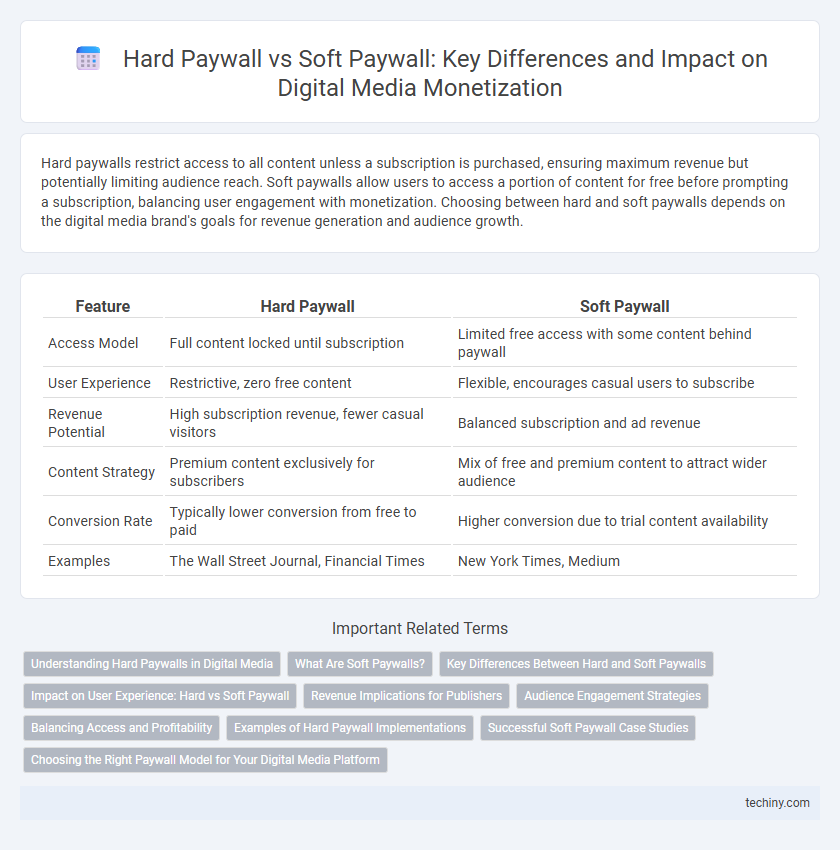Hard paywalls restrict access to all content unless a subscription is purchased, ensuring maximum revenue but potentially limiting audience reach. Soft paywalls allow users to access a portion of content for free before prompting a subscription, balancing user engagement with monetization. Choosing between hard and soft paywalls depends on the digital media brand's goals for revenue generation and audience growth.
Table of Comparison
| Feature | Hard Paywall | Soft Paywall |
|---|---|---|
| Access Model | Full content locked until subscription | Limited free access with some content behind paywall |
| User Experience | Restrictive, zero free content | Flexible, encourages casual users to subscribe |
| Revenue Potential | High subscription revenue, fewer casual visitors | Balanced subscription and ad revenue |
| Content Strategy | Premium content exclusively for subscribers | Mix of free and premium content to attract wider audience |
| Conversion Rate | Typically lower conversion from free to paid | Higher conversion due to trial content availability |
| Examples | The Wall Street Journal, Financial Times | New York Times, Medium |
Understanding Hard Paywalls in Digital Media
Hard paywalls in digital media restrict access to all or most content unless users subscribe or pay, ensuring consistent revenue streams for publishers. This model is favored by premium news outlets like The Wall Street Journal, as it cultivates high-value, engaged audiences willing to invest in exclusive, in-depth reporting. Despite potential limitations on casual readers, hard paywalls provide financial sustainability critical for independent journalism and quality content production.
What Are Soft Paywalls?
Soft paywalls allow users limited access to digital content before requiring a subscription, commonly enabling free views of a set number of articles monthly. This model balances user engagement with monetization, often used by news websites to attract casual readers while converting frequent visitors into paying subscribers. By leveraging user data and tailored content recommendations, soft paywalls optimize both retention and revenue generation in digital media.
Key Differences Between Hard and Soft Paywalls
Hard paywalls restrict all content access unless a subscription is purchased, ensuring complete content exclusivity and maximizing revenue from paying users. Soft paywalls allow limited free access to articles, often using metered or hybrid models to balance user engagement and subscription conversion. The key difference lies in the access level and user experience: hard paywalls offer zero free content while soft paywalls provide partial access to encourage subscription uptake.
Impact on User Experience: Hard vs Soft Paywall
Hard paywalls restrict access to all content without subscription, often leading to higher user frustration and reduced site traffic due to limited content previews. Soft paywalls allow users to access a set number of articles or limited content before requiring payment, enhancing user experience by providing value and encouraging subscription conversion. Studies show soft paywalls increase reader engagement and retention by balancing accessibility with monetization, while hard paywalls can deter casual visitors and lower overall site engagement.
Revenue Implications for Publishers
Hard paywalls generate higher immediate revenue by restricting content access exclusively to subscribers, fostering a loyal paying audience but potentially limiting overall readership growth. Soft paywalls balance revenue by offering some free content to attract casual readers, optimizing ad revenue alongside subscription fees and expanding long-term monetization opportunities. Publishers must analyze audience behavior and content value to strategically implement paywall types that maximize digital media revenue streams effectively.
Audience Engagement Strategies
Hard paywalls restrict access to all content without subscription, creating exclusivity but often limiting casual visitors and reducing overall traffic volume. Soft paywalls allow partial free content, using metered access or previews to entice readers and encourage gradual subscription conversion while maintaining higher audience engagement. Optimizing user experience and content personalization within soft paywalls enhances loyalty and drives sustainable revenue growth in digital media platforms.
Balancing Access and Profitability
Hard paywalls restrict all content behind a subscription, maximizing immediate revenue but limiting audience growth and engagement. Soft paywalls allow limited free access or metered views, enhancing user experience and expanding reach while encouraging subscriptions through sampling content. Balancing these models requires analyzing user behavior data and optimizing pricing strategies to sustain profitability without alienating potential customers.
Examples of Hard Paywall Implementations
Hard paywall implementations restrict access to all content without a subscription, exemplified by The Wall Street Journal, which requires users to subscribe before viewing any articles. The Financial Times employs a similar strategy, offering zero free articles and emphasizing exclusive content for paying members. These models capitalize on premium, high-value journalism to ensure steady subscriber revenue, contrasting sharply with softer, metered alternatives.
Successful Soft Paywall Case Studies
Soft paywalls have proven effective in digital media by allowing limited free access to content, encouraging user engagement before subscription. Notable case studies include The New York Times, which increased subscriptions by offering a metered model that balances free articles with premium content. The Guardian's voluntary contribution model also showcases success by fostering community support without strict access restrictions.
Choosing the Right Paywall Model for Your Digital Media Platform
Selecting the right paywall model for your digital media platform hinges on audience behavior and revenue goals, where hard paywalls restrict all content without subscription, ensuring higher direct revenue but potentially limiting audience growth. Soft paywalls offer a flexible approach by allowing partial free access with metered limits or premium content behind the paywall, fostering user engagement and gradual conversion. Analyzing user metrics and content value helps in implementing a tailored paywall strategy that balances subscriber acquisition with long-term retention.
Hard Paywall vs Soft Paywall Infographic

 techiny.com
techiny.com